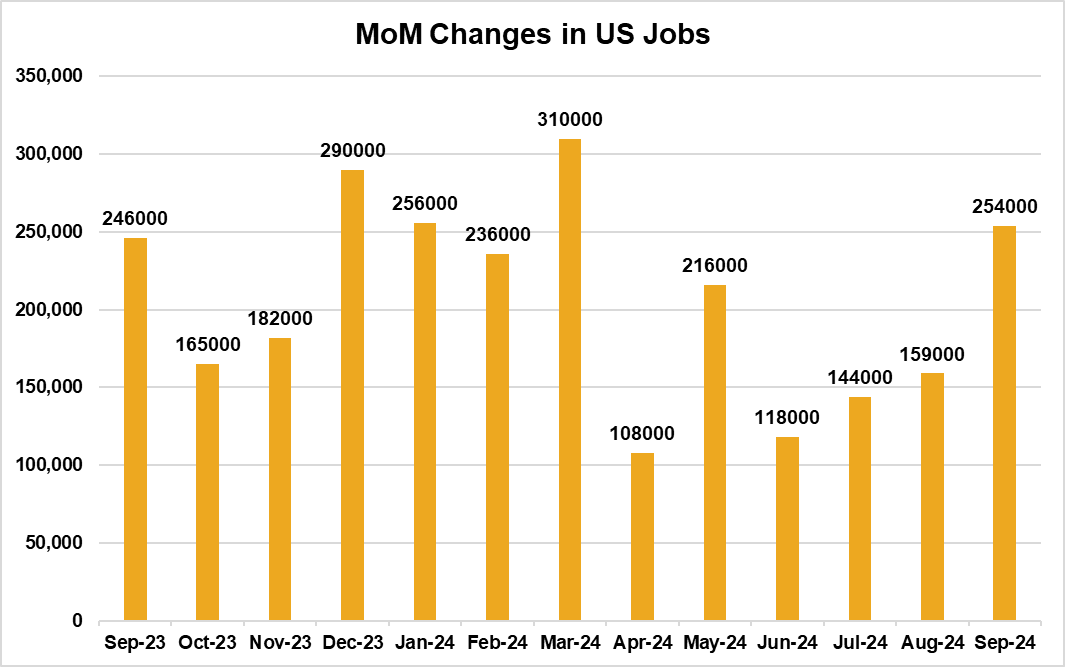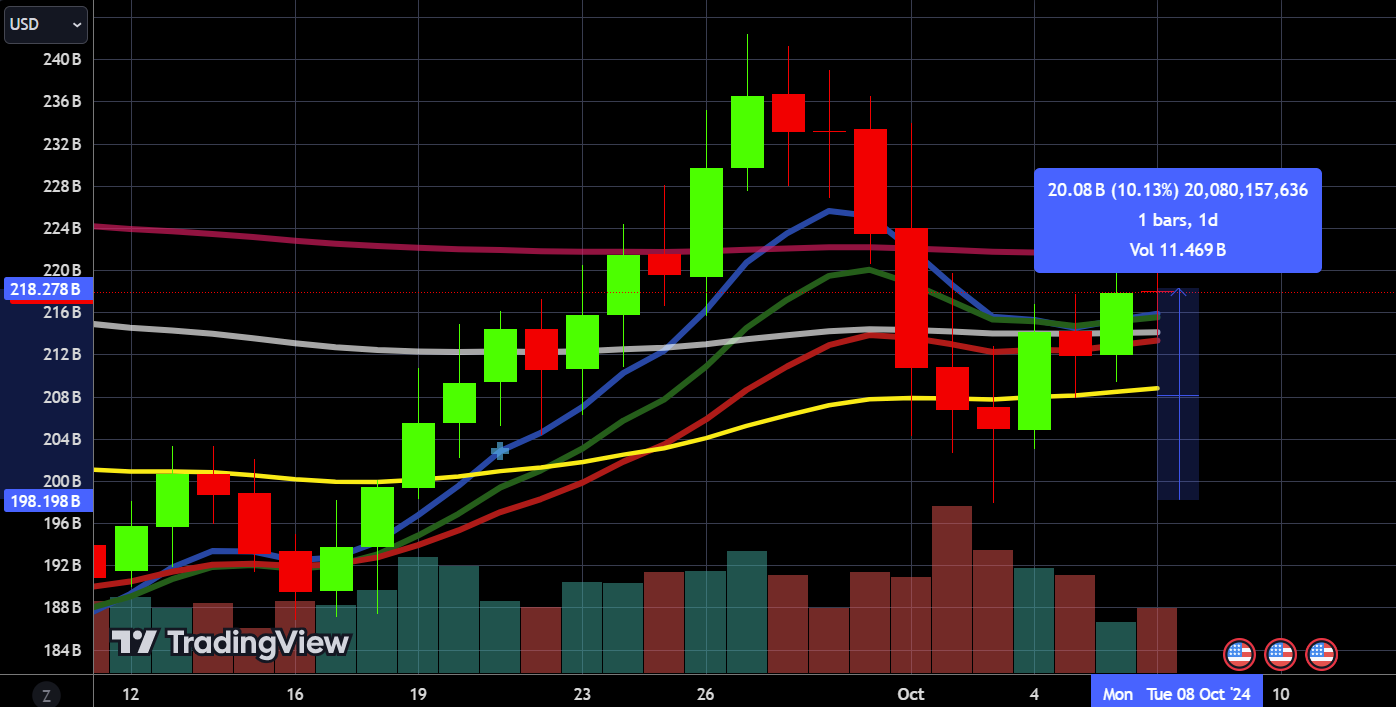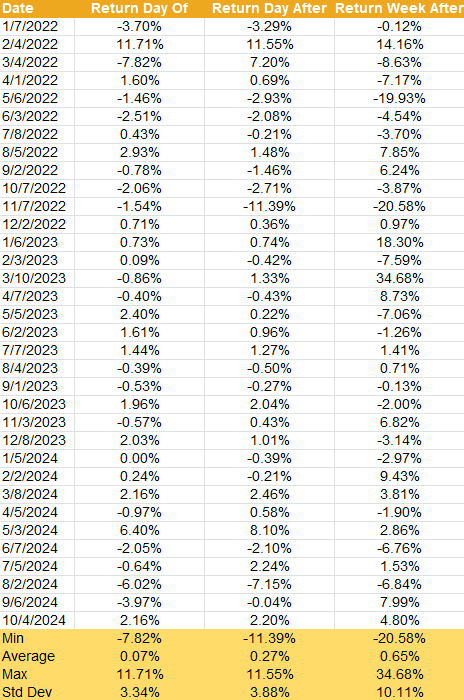
Unlike August’s disappointing figures, September's nonfarm payroll numbers shattered expectations, with the U.S. economy adding 254,000 jobs—far surpassing the anticipated 132,500. In a further boost, the Labor Department revised July and August figures upward, adding 72,000 more jobs, which helps to alleviate concerns about the labor market and dampens fears of a recession. The positive momentum continued as the unemployment rate dipped to 4.1%, signaling the strength and resilience of the economy.
Figure 1: MoM Changes in US Jobs

Job Growth Exceeds Expectations, Fueling Market Gains
Both the digital asset and traditional markets responded strongly to the latest jobs data.
Despite escalating tensions in the Middle East, the robust jobs report triggered a market rally, highlighting just how sensitive markets have become to macroeconomic data. Investors are paying closer attention than ever. The S&P 500 and NASDAQ both rebounded nearly 1% from their daily lows, recovering most of their weekly losses.
Digital assets, however, emerged as the clear winners. By Friday, Bitcoin (BTC) gained over 2%, Ethereum (ETH) climbed more than 3%, and Solana (SOL) surged nearly 6%. This signals a shift towards a more risk-on sentiment, with investors seeing the strong jobs report as an encouraging factor. SOL's outperformance, compared to BTC and ETH, reflects its position further down the risk curve. Supporting this trend, the OTHERS Index—representing the total market cap of digital assets excluding the top 10 by market cap—jumped from last week's low of $198 billion to $220 billion, a rise of over 10%.
Figure 2: OTHERS Index Daily Candles Chart

The stronger-than-expected September nonfarm payroll data, alongside upward revisions for July and August, could play a pivotal role in shaping both digital asset prices and the Federal Reserve's next move. The impressive job growth signals economic resilience, which in turn fosters a "risk-on" sentiment. This could accelerate speculation about the Fed's future policy decisions and their impact on risk assets, such as digital assets.
- Increased Investor Confidence: Strong job growth reduces recession fears, prompting investors to take on riskier assets. Digital assets, known for their volatility, could attract more capital as investors seek higher returns in a strengthening economy. This could lead the Fed to slow the pace of rate cuts to prevent overheating.
- Liquidity Boost: A stronger labor market increases consumer spending, which could shift capital from safe-haven assets like treasuries to equities and digital assets, boosting demand in these markets.
- Fed Policy Speculation: The stronger-than-expected jobs report has sparked questions about how aggressively the Federal Reserve will adjust its monetary policy. Investors are now anticipating that the Fed may opt for smaller, more gradual rate cuts. This shift is reflected in the CME FedWatch Tool: just last week, market participants were pricing in a 34.7% chance of a 50 basis-point (bps) rate cut at the next Fed meeting. However, following the robust jobs data, the market now sees a 0% chance of a 50 bps cut, underscoring the impact of the latest employment numbers on rate expectations.
- Risk Curve Shifts: With a risk-on sentiment taking hold, altcoins and smaller-cap digital assets could outperform, as they typically carry higher risk compared to established cryptocurrencies like Bitcoin (BTC) and Ethereum (ETH). Solana’s (SOL) recent 6% surge is evidence of investors venturing further down the risk curve.
- Capital Flows into Alternatives: As traditional markets rally, some investors may look to diversify into alternative assets like digital assets. The growing appetite for digital assets could prompt the Fed to carefully calibrate its next rate move, balancing the need to keep liquidity flowing while mitigating the risk of speculative bubbles.
Nonfarm Payroll Impact on Bitcoin: A Historical Statistical Analysis
The data in figure 3 captures market reactions to the release of nonfarm payroll reports, showing returns "Day Of," "Day After," and "Week After" the report. It reveals how reactant markets can be to labor market data.
Figure 3: Bitcoin’s Price Return With Respect to Nonfarm Payroll Release, N=34

For example, on February 4, 2022, the nonfarm payroll release sparked an immediate 11.71% gain "Day Of", followed by an equally impressive 11.55% rise "Day After", with the rally continuing for a 14.16% return "Week After." In contrast, March 4, 2022 saw a sharp 7.82% decline "Day Of", a recovery of 7.20% "Day After", but ultimately a negative 8.63% "Week After" return, highlighting the mixed market reactions depending on broader macroeconomic conditions.
On average, the nonfarm payroll report triggers only modest movements, with a 0.07% average return "Day Of", 0.27% "Day After", and a 0.65% return "Week After." However, the standard deviation of 3.34% (Day Of), 3.88% (Day After), and 10.11% (Week After) points to significant volatility, with large outliers both to the upside and downside.
The largest positive reaction was on March 10, 2023, where despite an initial 0.86% decline "Day Of", the market rebounded strongly, producing a 34.68% gain "Week After." Conversely, November 7, 2022 had the most severe negative reaction, with a 1.54% drop "Day Of," worsening to 11.39% "Day After" and ultimately ending with a 20.58% loss "Week After.". It's important to highlight that the data from March 10, 2023, coincided with the regional banking crisis, during which BTC surged as investors turned to it as a flight-to-safety asset. Similarly, the data from November 7, 2022, reflects the aftermath of the FTX collapse. These two market-shaking events may skew the dataset, as they triggered significant, atypical market movements.
This data highlights how nonfarm payroll figures can significantly and unpredictably impact market sentiment. While strong reports often generate immediate optimism, the gains are not always sustained, as market direction can swiftly shift when investors digest the broader implications of labor market data. Ultimately, this favorable labor market performance, coupled with increased speculation about the Fed's next moves, could set the stage for further gains across both stock and digital asset markets as investors navigate the evolving macroeconomic landscape.


.svg)



_logo.svg)

.svg.png)